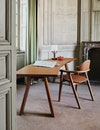A Human Odyssey is the design and communication theme chosen this year by Pierre-Alexis Dumas, artistic director of Hermès. It is also the leitmotif running through
Métiers desk and chair in bull-calf leather and Canaletto walnut, designed by Enzo Mari, Harnais lamp designed by Michele De Lucchi and Cèlèbes box.
© RVZ
Excellence is the theme of this issue of L’Uomo Vogue. How would you define excellence?
I think excellence is a goal, a result. You have to create the right conditions for excellence to emerge. It’s not up to me to declare our excellence. I hope the customer will see it, saying: “I have this product and it has never disappointed me, so you as a house have the values of excellence.” Thinking about this word, for Hermès it means going back to our roots. We started as artisans, and we’re still artisans today. There are over 5,000 craftspeople working with us. The essence of Hermès is founded on know-how and the daily practice of working with materials. That’s where excellence begins – with learning, with a concern for the work. It also exists thanks to a concept that’s very dear to me: the quality, not the quantity, of the time we spend at work. To my mind, excellence is a horizon, a fixed direction, but what is stimulating is the journey.
Taking responsibility for the artistic direction of Hermès sounds very demanding.
That’s not really so. What is truly difficult is to do one’s job well and keep developing. I love my work. I’ve had the good fortune to grow up in this company, and I’ve been able to build an artistic direction that not only matches the values of Hermès, but also represents me. I have a different way of working from my father, Jean-Louis Dumas, who ran Hermès and was also its artistic director. And he had a different approach from his father, and his father from his grandfather, and so on. In any case, this firm has great consideration for people, and that’s also a form of excellence. When the many people who work in a company have no desire to leave, when they stay on and make a career, this tells us something interesting: that we’re good, we inspire a special attachment, and there’s a strong business culture. This ensures that our project continues to exist and is handed down to others. But passing it on is hard. I say this because I’m 55, and I often think about how I’m going to hand over the culture to the next generation and new talents.
Coulisse table lamp designed by Tomás Alonso, in bamboo, washi paper and copper-coated steel.
© RVZ
You have a passion for design and architecture, and since 2016 you’ve also been president of the Musée des Arts Décoratifs in Paris. What do these two disciplines have in common with your world and with excellence in the decorative arts? And how do they differ?
It’s in my nature to be curious. I studied art history and I’m interested in creativity, especially when applied to objects. Curiosity means being able to learn. If we think about Hermès, it has different ways of applying its know-how. It’s built on simple and fundamental values, and this applies to all the types of objects we produce. One of our main values is functionality. An object is Hermès if it has a function. We started out making harnesses for horses and carriages, then saddles, and now bags and clothes. All these objects are beautiful, I hope, but before being beautiful they have to work. This is a cardinal virtue. If an object isn’t totally reliable in performing its function, we can hardly speak of excellence. For example, a bag has to close perfectly. This is an objective notion about direct functionality, but there’s also a subjective idea concerning comfort, pleasure and sensation.
If the object works but gives no pleasure, something is wrong. The notion of excellence is superior to other aspects because it applies true empathy and sensitivity to others; it means thinking about everything. Enzo Mari is a fine example. I was lucky enough to work with him ten years ago, and I asked him to design a chair. He took a sheet of paper and a pencil right in front of me, then very spontaneously drew a shape and said: “Here it is.” We put it into production and we’re still producing it today. The armrests, the backrest and the wood are absolutely perfect for sitting down. When we made the prototype, Mari tried it and said: “Perfect. If you want to make a chair, you really have to try it out.” Excellence lies in thinking about the effect an object will have on its user. This is a form of empathy, a great human quality that needs to be cultivated. But there’s even more to it. You also have to think about the impact on nature, the consumption of resources. If we want excellence today, we need to think globally and as rigorously as possible. The world changes, consciousness evolves, people’s position in nature changes, so we really need to reflect and ask ourselves questions.
(Continues)
Opening picture: a portrait of Pierre-Alexis Dumas, from “Harpers Bazaar” USA, 1 February 2013.

